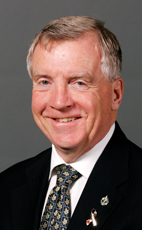Mr. Speaker, I am very pleased to speak in favour of this motion. I know that my colleague from Wetaskiwin has been working very hard in the preparation of this motion and is a great supporter of the cadet program that is bringing a positive choice to the youth of the four bands of Hobbema, all the while curtailing the tide of violence and the spread of gang recruitment that is plaguing those reserves.
Today, over 1,050 cadets have registered in this program. There are 65 registered cadet instructors. There is one Hobbema RCMP community cadet corps program coordinator and one RCMP provincial youth cadet program manager. There are also five parent volunteers and three senior cadets, who recently turned 18 and are waiting to be trained as adult cadet Instructors. That is real teamwork.
I want to take a few minutes to outline why this motion should be passed and to speak of the successes currently happening in the Hobbema community cadet corps program.
First, and foremost, the cadet program started with the four individual bands and brought them together as a collective unit to solve problems, learn tolerance and work patiently with each other, resulting in their parents and elders working jointly.
The cadet program has attracted hundreds of members since forming four years ago. It was developed and implemented by the RCMP as a comprehensive crime reduction initiative, while educating first nations youth on the dangers of gang activity, drug abuse and associated violence.
The program is recruiting first nations youth and is advising them on positive choices and alternatives to overcome daily negative obstacles that prevent them from obtaining future education and career opportunities. It has partnered up with local businesses to help members with scholarships and jobs.
I know that many of the involved youth are going to look back and think fondly of their experiences in the cadet corps as they embrace leadership positions as adults. Their time in the program might even lead to some becoming members of the RCMP, the Canadian Forces, or other similar groups.
The program is empowering young people to make decisions and solve problems affecting them and their cadet corps, as well as their families, schools and communities.
The cadet corps provides a safe, secure, positive peer group and a strong support system, allowing them to learn to grow and respect each other and themselves.
As well, the program teaches the Cree language to all the cadets, while the elders teach wisdom, knowledge and the understanding of the Cree culture.
With the co-operation of community agencies, such as social, mental health, police and fire and ambulance services, as well as youth development, the cadet corps is working collectively like never before. In light of this success story, it is my wish to see such an achievement repeated in first nations communities across Canada.
The Hobbema community cadet corps program is now known as the largest aboriginal cadet program around the world and has partnered up with the national inter-school brigade Jamaica police cadet corps program.
Since the cadet program was developed, school attendance has risen and crime has significantly been reduced in the community. The program's youth empowerment and crime reduction model has received national interest among aboriginal, academic and police communities. And with the passage of the motion, we can promote cadet programs in all of Canada's first nations communities.
I want to strongly encourage chiefs, elders, parents, sponsors, surrounding communities, and the RCMP to work with the cadet program organizers to ensure it continues and succeeds.
On a final note, I want the young people involved in the program to know that I am inspired and impressed with their dedication and hard work. They have built the program from the grassroots up and have made a tremendous difference in their community.
I represent an intercity riding in the city of Edmonton. The city of Edmonton has, as many people may know, or will shortly, the highest number of urban aboriginals in Canada. It is incredibly important that we address the challenges of aboriginal youth, whether it is in urban settings like Edmonton or rural settings like Wetaskiwin. They are some of our future leaders and we need to give them every encouragement and every opportunity to reach their full potential in a safe environment.
Again, I urge all members of this House to vote in favour of this motion, and I want to thank my hon. friend from Wetaskiwin, who has worked tirelessly to advance this issue.

